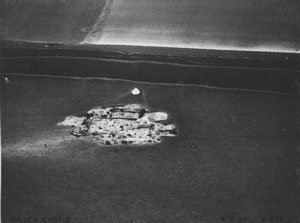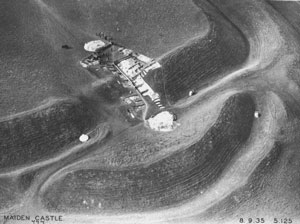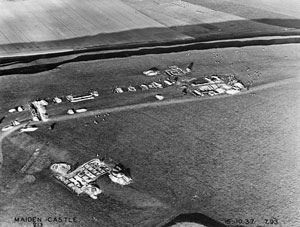
The Ashmolean Museum holds approximately 2000 aerial photographs taken by Major George Allen between 1933 and 1939. Amongst the photographs are images of Maiden Castle in Dorset and the excavations undertaken on the site by Sir Mortimer Wheeler.
Certainly not the largest of the hillforts in the area around Dorset, Maiden Castle boasts the most impressive earthworks to be found anywhere in Britain. The daunting series of fortifications were designed to protect the neolithic and Iron Age community from advancing groups, which included the Romans.
Although not the first to dig into Maiden Castle, the famed archaeologist Sir Mortimer Wheeler was the first to conduct methodical excavations of any considerable scale at the site. Wheeler spent the four seasons from 1934-1937 identifying the scale of the neolithic, Bronze Age, Iron Age and dwindling Roman occupation of the site. The neolithic community occupied the eastern half of the hill until the fortifications were expanded in the Iron Age.
These aerial photographs document the progress of the excavations of Maiden Castle from 1934-1937. Below is a brief summary of the excavataion sites noted in the photograph descriptions.
- Site A – A trench dug through the western defences of the original Iron Age camp in order to determine their extent, character and date. See site H.
- Site B– An area re-excavated by Wheeler containing a Romano-Celtic temple and adjacent lodging. First excavated in 1882 by Edward Cunnington.
- Site D – An area of settlement sheltered by the high south-east corner ramparts. Nine huts were excavated.
- Site E – A cut through the rampart construction in a well-preserved stretch south of the westen entrance.
- Sites F and G and the eastern entrance – The eastern end was completely explored in seven trenches from 1935-1937. The trenches F and G explored the two gate portals. Other trenches explored the war-cemetary of c.43 A.D. and the eastern fortifications.
- Site H – A trench dug to prove that the eastern unit of Maiden Castle was in fact a separate and earlier entity. The trench was dug along the line of the original ditch surrounding the eastern unit. See site A.
- Sites L and Q – Trenches dug near the eastern end of the neolithic Long Mound and site B, revealing features from a wide range of cultures.
- Site R – Trench to locate the original western entrance of the eastern Maiden Castle unit.
Traces of the neolithic village were found in sites A, F, G, L, Q, and R.
Click to enlarge

Maiden Castle Iron Age hillfort taken 31 Mar 1934 (Album Ref 6, 63)

Excavations of Roman Temple and House,Site B, taken 8 Sept 1934 (Album Ref 7, 84).

Excavations of Site F, East Entrance, taken 8 Sept 1935 (Album Ref 11, 5).

Excavations of Site R and the Neolithic Long Mound taken from the south looking north on 16 October 1937 (Album Ref 14, 76).
Further Information
Wheeler, R.E.M., 'Maiden Castle, Dorset', Reports of the Research Committee of the Society of Antiquaries of London, 13 (Oxford: Oxford University Press, 1943)
Find out more about:
- Major George Allen and his aerial photographs held by the Ashmolean Museum
- Collection of Aerial Photographs taken by Major Allen - searchable database of the collection
- British Neolithic, Bronze Age and Iron Age collections at the Ashmolean Museum
- British Collections Online - searchable database of the collection
Sarah Glover
January 2012